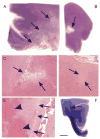Vascular dementia: different forms of vessel disorders contribute to the development of dementia in the elderly brain
- PMID: 22705146
- PMCID: PMC3470831
- DOI: 10.1016/j.exger.2012.05.023
Vascular dementia: different forms of vessel disorders contribute to the development of dementia in the elderly brain
Abstract
The diagnosis of vascular dementia (VaD) describes a group of various vessel disorders with different types of vascular lesions that finally contribute to the development of dementia. Most common forms of VaD in the elderly brain are subcortical vascular encephalopathy, strategic infarct dementia, and the multi infarct encephalopathy. Hereditary forms of VaD are rare. Most common is the cerebral autosomal dominant arteriopathy with subcortical infarcts and leukoencephalopathy (CADASIL). Sporadic forms of VaD are caused by degenerative vessel disorders such as atherosclerosis, small vessel disease (SVD) including small vessel arteriosclerosis, arteriolosclerosis, and lipohyalinosis, and cerebral amyloid angiopathy (CAA). Less frequently inflammatory vessel disorders and tumor-associated vessel lesions (e.g. angiocentric T-cell or angiotropic large cell lymphoma) can cause symptoms of dementia. Here, we review and discuss the impact of vessel disorders to distinct vascular brain tissue lesions and to the development of dementia in elderly individuals. The impact of coexisting neurodegenerative pathology in the elderly brain to VaD as well as the correlation between SVD and CAA expansion in the brain parenchyma with that of Alzheimer's disease (AD)-related pathology is highlighted. We conclude that "pure" VaD is rare and most frequently caused by infarctions. However, there is a significant contribution of vascular lesions and vessel pathology to the development of dementia that may go beyond tissue damage due to vascular lesions. Insufficient blood blow and alterations of the perivascular drainage mechanisms of the brain may also lead to a reduced protein clearance from extracellular space and subsequent increase of proteins in the brain parenchyma, such as the amyloid β-protein, and foster, thereby, the development of AD-related neurodegeneration. As such, it seems to be important for clinical practice to consider treatment of potentially coexisting AD pathology in cognitively impaired patients with vascular lesions.
Copyright © 2012 Elsevier Inc. All rights reserved.
Figures



References
-
- Alafuzoff I, Adolfsson R, Grundke-Iqbal I, Winblad B. Perivascular deposits of serum proteins in cerebral cortex in vascular dementia. Acta Neuropathol. 1985;66:292–298. - PubMed
-
- Alafuzoff I, Al-Sarraj S, Arzberger T, Attems J, Bodi I, Bogdanovic N, Budka H, Bugiani O, Englund E, Ferrer I, Gelpi E, Gentleman S, Giaccone G, Graeber M, Hortobagyi T, Hoftberger R, Ironside J, Jellinger K, Kavantzas M, King A, Korkolopoulou P, Kovacs GG, Meyronet D, Monoranu C, Parchi P, Patsouris E, Roggendorf W, Rozemuller A, Seilhean D, Streichenberger N, Thal DR, Wharton S, Kretzschmar H. Diversity of neuropathological assessments of vascular alterations in the ageing brain. Multicenter survey by the BrainNet Europe consortium. Exp Gerontol. 2012 in consideration. - PubMed
-
- American Psychiatric Association. Diagnostic and statistical manual of mental disorders. Washington DC: 1994.
-
- Attems J. Sporadic cerebral amyloid angiopathy: pathology, clinical implications, and possible pathomechanisms. Acta Neuropathol. 2005;110:345–359. - PubMed

